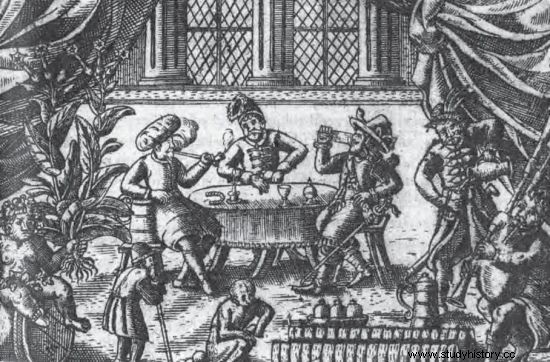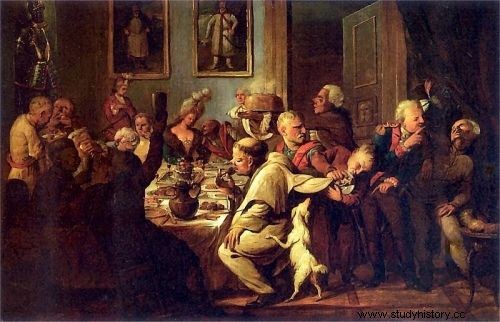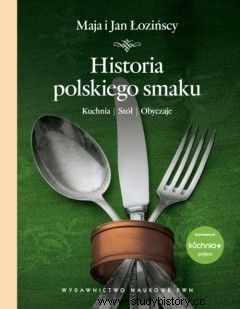A well-known cliche says:"Eat, drink and unleash your belt for King Saxon." There is no exaggeration in these words. In the decline of the Polish nobility, sumptuous feasts were held day after day, and people drank so much that many hungover noblemen ... might not have noticed the partitions at all.
The numbers alone testify to the scale of the nobility's love for alcoholic beverages at that time. According to historians' estimates, the inhabitants of manor houses and wealthy townspeople drank about 20 liters of vodka and over 700 liters of beer annually per capita in the Saxon times. . Today, for comparison, the statistical annual alcohol consumption is about 7 liters of spirit per person. So much, much less…
A certain diarist, Adam Moszczeński, recalled that: During the reign of Augustus III, the whole country had not sobered up yet, broken up by Augustus II. In turn, priest Jędrzej Kitowicz stated in "Description of the customs during the reign of Augustus III":
Where beer was fashionable, they drank it from breakfast to lunch, from dinner to pillow. He went on to add: Some of them had such a good throat and such a spacious belly that they drank a mug of beer or a glass of it (...) with a gulp without rest.

Eighteenth-century feast on copperplate from the era. Illustration from the "History of Polish Taste".
Indeed, beer was the most popular drink in Poland. They were brewed in almost every noble estate, so the number of species and recipes was not even hundreds, but thousands.
Importantly, the most so-called thin ones, containing no more than 2-3% of alcohol, were produced. This explains why the nobles were able to drink up to a dozen pints during one game, and throughout the year - often a thousand or more liters .
Grodzisk beer enjoyed a good reputation in Wielkopolska. According to Kitowicz: thin and tasty, heads not bothering, so that a noble who did not have Grodzisk beer in his house was considered a poor man or a penny . Many other reputable Polish beers were mentioned by the authors of the book "Historia Polskiego Taste". With reference to the 18th century, these include, among others, Otwock, Wilanów, Wąchock, Gielniów, Bukackie and Tylża liquors.
Lesser Poland stood out against this background, where only… English beer was considered appropriate! Strong and frothy beers were imported straight from London, but they were goods only for the wealthiest. The average noblemen were condemned to counterfeit Polish porters, brewed, among others, in Obory near Warsaw.

An 18th-century feast at the Radziwiłł court. The booze is pouring in streams…
Due to the great variety and richness of the beer offer, the alcohol connoisseurs could not complain about the lack of work. The best experts in this matter were ... clergymen and coachmen. According to Maja and Jan Łoziński, authors of "The History of Polish Taste", there was even a saying: where priests and carters drink, the best beer is there .
The second most popular drink after beer was booze. Most often it was chased from rye, and only occasionally from wheat or plums. Importantly, it was still a road drink, and therefore available mainly to wealthy people. Vodka will not gain popularity among the peasants until the next century, when its production of potatoes becomes widespread.

The article is based on the "History of Polish Taste" by Maja and Jan Łoziński (PWN 2012).
Due to this price barrier, even rich Poles often saved and secretly drank the cheapest alcohol available - the so-called "ordinarian". A foreign traveler wrote in his memoirs: The most aristocratic Poles take it with them in their boxes and have to drink it almost every hour.
It is difficult to judge whether a statistical nobleman actually drank that much, but there were certainly no known limits to the time of day. In the 18th century, a cultured Pole would never have thought that he was drinking from 12 or 1 p.m. The first glass of vodka was consumed at breakfast. To warm up! And with this nice accent we wish our readers a tasty ...
Source:
Maja and Jan Łozińscy, History of Polish taste , Polish Scientific Publishers PWN 2012.
